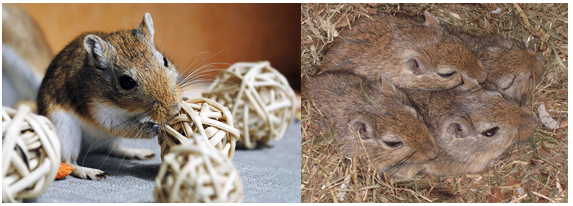

Gerbils are native to the Mongolian Desert Steppes in Asia. Family groups of gerbils live in burrows in the loamy soil. During summer months they eat green plant materials and gather seeds and grains to store in their burrows for use during the winter months. Since they are native to an arid habitat, they drink very little water and gain the moisture they require from their food.
A typical gerbil food mix contains sunflower seeds, milo, millet, peanuts and pelleted or extruded grain products. Gerbils require a slightly higher protein diet than hamsters and may be subject to vitamin deficiencies. Because of this, we recommend supplementing their diet with a multivitamin if the diet is not already vitamin enhanced.
Small quantities of fresh vegetables and greens should be offered on a regular basis.
Even though they don’t drink much water, it must always be available in a drinking tube or water bottle made specifically for small animals.
Gerbils are kept in wire cages, aquariums with wire screen tops, and plastic molded habitats. Wire cages are not as common because the constant digging and burrowing of gerbils can push the bedding out of the cage, making a mess around it.
Aquariums with wire screen tops are the most commonly used cages. Aquariums are difficult for gerbils to escape from, they keep the bedding in place, they’re easy to clean, and they provide an unobstructed view into the gerbil’s environment. A deep layer of bedding material should be used to cover the bottom of the aquarium to allow the gerbils to dig and burrow as they would in the wild.
Molded plastic habitats are popular with children. They have many of the same advantages as an aquarium, and they often provide additional features to enrich the life of the animals, but they do have a few drawbacks. The plastic is easy to chew through and the gerbils will often chew holes in the cage or tubes and escape. The plastic also becomes cloudy over time, and is much harder to clean than a glass aquarium.
No matter which housing option you choose, you should also provide a wheel and several places for them to hide. There are many types of wheels and hides available on the market, but if you’re looking for something inexpensive, paper towel tubes make great hiding places.
Gerbils are curious social animals. They do well when kept in pairs or large groups. Pairs do not have to be mated pairs as two males will get along just as well as two females.
Gerbils are easy to handle. Simply place your hand out flat, palm up on the floor of their cage, and scoop the gerbil up in the palm of your hand. Never pick a gerbil up by it’s tail, as the skin can tar off and peel, exposing the underlying tissue and bone.
Traditionally pine shavings have been used as bedding material for these animals. Aspen bedding is another great choice of bedding. Avoid using red cedar shavings for gerbils. The phenols in red cedar shavings are not safe for gerbils and can cause serious respiratory, skin, coat and liver problems.
© 2024 F.M. Brown's Sons, Inc.